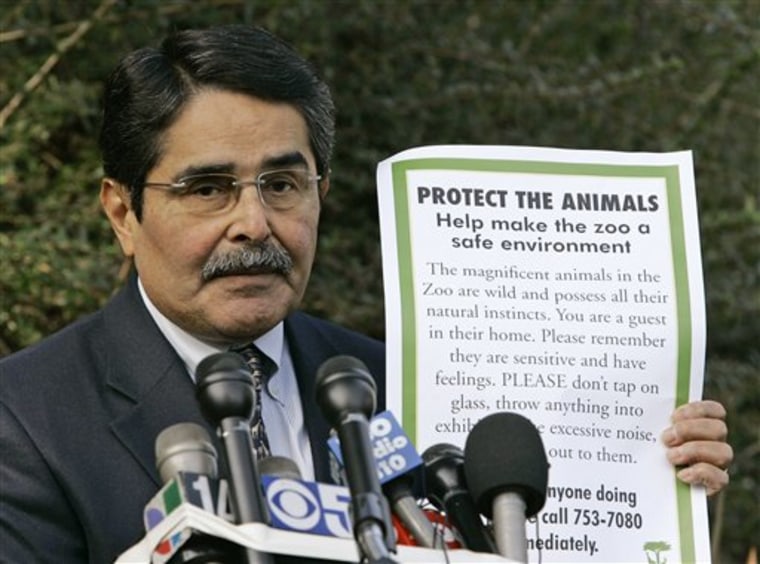Since the deadly tiger escape at the San Francisco Zoo, its director has come under increasing criticism over his track record and his suggestion that the victims brought the attack on themselves by taunting the animal.
The lawyer for the two of the visitors mauled in the Christmas Day attack is threatening a defamation lawsuit over what he claims is a despicable blame-the-victim strategy on the part of the zoo, and animal rights activists have long accused Zoo Director Manuel Mollinedo of putting too much emphasis on showmanship.
"We've asked for his termination," said Elliot Katz, president of In Defense of Animals.
So far, the American Zoo and Aquarium Association, which accredits the nation's zoos, and the San Francisco zoo's overseers are standing by Mollinedo.
"Since Manuel joined us in 2004, the zoo is in better physical and financial shape than it's ever been," said Nick Podell, president of the San Francisco Zoological Society. He praised Mollinedo's handling of the attack.
AZA spokesman Steve Feldman added that Mollinedo is "well-liked and well regarded" within the industry.
Praised for work at Los Angeles Zoo
Before coming to San Francisco, Mollinedo was widely praised for his work at the long-neglected Los Angeles Zoo, even though a dozen animals slipped out of their enclosures during the course of a year.
Mollinedo was the unanimous choice over more than 100 candidates for the San Francisco job. He makes about $330,000 a year in salary and benefits, and under his leadership the zoo has seen increased attendance, new corporate sponsors and refurbished exhibits at the Depression-era facility.
Then came the Christmas Day tiger attack. The 350-pound Siberian tiger apparently jumped over a 12 1/2-foot wall around its pen and killed 17-year-old Carlos Sousa Jr. His friends, brothers Kulbir Dhaliwal, 23, and Paul Dhaliwal, 19, were severely mauled.
At first, the zoo's response seemed confused and disorganized. Police radio transcripts reveal that zoo employees initially questioned whether early reports of the attack were coming from a mentally unstable person.
When questioned by reporters, Mollinedo gave an inaccurate figure for the wall's height, putting it at 18 feet. Then, two days after the attack, he acknowledged the wall was only 12 1/2 feet — or 4 feet below the recommended national standard.
Several days after the mauling, the zoo hired Sam Singer, a prominent San Francisco Bay-area crisis-management specialist. Acknowledging that the zoo had bungled its initial response, Singer adopted a new strategy.
Soon, the public and the media's attention turned from the competence of zoo officials and the substandard tiger exhibit to the victims' behavior leading up to the escape.
At a news conference, Mollinedo suggested "something happened to provoke that tiger to leap out of her exhibit."
Crisis expert leaked slingshot info
A rash of false information soon emerged in the media, including reports that the victims had slingshots and had been drinking in an establishment near the zoo.
Singer admitted on Tuesday that he told reporters about the slingshot rumor, but said he was passing along information he had heard elsewhere. He denied planting the rumor about the bar.
"Police are investigating accusations of the use of a slingshot and the possible use of stones, pine cones, or other pieces of wood or that may have been used to taunt the tiger," Singer said Tuesday. "That's fact."
A police spokesman said last week that investigators quickly dismissed the slingshot allegation as inaccurate.
Singer was recently hired by the San Francisco Bar Pilots Association after a cargo ship hit a bridge and spilled oil into San Francisco Bay in November. He also handled Jack in the Box's hamburger contamination scare in the mid-1990s, and recently represented Mayor Gavin Newsom's former campaign manager, who resigned after his wife had an affair with the mayor.
Mark Geragos, the lawyer for the mauled survivors of the tiger attack, lambasted his tactics as "an abomination" and threatened to sue for defamation.
"To be attacked by a tiger, number one, then to be attacked viciously by false and defamatory stuff is too much," Geragos said.
In a letter to the city attorney Monday, he also said zoo officials knew that the wall around the tiger habitat "couldn't hold a house cat," but they did not do anything about it because of financial concerns.
Singer said no one at the zoo was aware of such a warning.
Cats more aggressive now?
Animal rights activists have long accused of Mollinedo of putting entertainment over animals' well-being.
"There just been a lack of respect for the animals to increase foot traffic," Katz said. Mollinedo's crowd-pleasing initiatives, such as public feedings of big cats, have made them more aggressive, he said.
Mollinedo had previously clashed with the organization over the conditions in which its elephants were kept. Two of the animals died in 2004.
The escapes from the Los Angeles Zoo during Mollinedo's tenure included a gorilla that bent a steel door, a howler monkey that sprang over a surprised keeper, and a snow leopard that got out of its holding area when a zookeeper failed to secure the door. All the animals were recaptured and no people were injured.
Several experts said such incidents are not unusual, although a dozen in a year from one zoo appears to be a high number. The American Zoo and Aquarium Association withheld the zoo's accreditation for a time, but it was for poor management and health and safety violations prior to Mollinedo's arrival.
City officials in Los Angeles praised Mollinedo for helping to turn their zoo around. He raised money to revamp the disease-ridden, cramped facility, refurbish animal quarters, and a build a new hospital.
City officials in San Francisco have also defended Mollinedo's leadership.
"He's been a very effective leader," said David Lee, a recreation and parks commissioner. "The zoo is an old institution, very traditional, and some felt it hadn't changed much until Manuel came up. He brought innovation, new ideas, and everyone benefited from that, people and animals."
